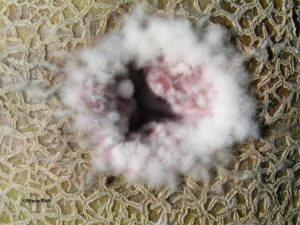Fusarium Rot of Cucurbits
Pest Management Fact Sheet #5093
Authors: Dr. Alicyn Smart, Dr. Bruce Watt, Abigayl Novak, and Nathan Andrews
For information about UMaine Extension programs and resources, visit extension.umaine.edu.
Find more of our publications and books at extension.umaine.edu/publications/.
Other Name: Fusarium Wilt of Cucurbits, Fusarium Fruit Rot
Pathogen: Fusarium solani f.sp. cucurbitae
Introduction

Fusarium Rot of Cucurbits is a fungal disease that can affect the roots, stem, and fruit, particularly pumpkins and squash. The disease consists of two different races (pathovars) — race 1 targets the stems, roots, and fruit of the plant while race 2 only targets the fruit. Cool, wet conditions tend to be the most favorable for this pathogen to grow. Infection of fruit is greatest in fruit that is in direct contact with soil. Fusarium rot can also be an opportunistic disease, infecting hosts after winter damage, fertilizer injury or a primary pathogen has weakened the plant, making it more susceptible to other pathogens.
Host Plants
- Cucurbits (family Cucurbitaceae)
Management
- Remove all infected plants
- Use clean seed during planting
- Rotate cucurbit crops out every 3-4 years
- Space out plants out while planting to increase airflow.
- There are no resistant varieties or effective fungicides for this disease
You should check your local town ordinance for any pesticide restrictions before application
Symptoms and Signs
Initial infection of the whole plant may appear as damping off during the seedling stage. Wilting may be seen during the warmest part of the day and then in the evening the plant recovers. This is because the fungi inhabit the space where water is transported, and the plant is then unable to transport sufficient amounts of water to the leaves. During the cooler temperatures of the evening, the plant can regain the turgor pressure of the leaves. Browning of the main stem at the soil line is also commonly seen and possibly a rot if found in wet conditions or a scar in dry conditions.
Initial infection of fruit will begin where the fruit touches the soil. Infected fruit will develop lesions that are usually circular and can vary in size. The tissue beneath can be discolored and have a corky texture. As lesions develop, the coloration will progress to a whitish pink, and rot will form. Fusarium rot is initially dry and firm, but secondary organisms may cause a wet rot to form.
References
Seebold, Kenny (2010, November). Fruit Rot of Cucurbits. Retrieved from University of Kentucky – Plant Pathology Extension: https://plantpathology.ca.uky.edu/files/ppfs-vg-07.pdf
Fusarium Fruit Rot. 2013. Retrieved from University of Massachusetts Amherst Extension: https://ag.umass.edu/vegetable/fact-sheets/cucurbits-fusarium-fruit-rot
Zitter, Thomas A, Donald L. Hopkins and Claude E. Thomas. Compendium of Cucurbit DiseasesThe American Phytopathological Society. Copyright 1996. Print.
WHEN USING PESTICIDES, ALWAYS FOLLOW LABEL DIRECTIONS!
Alicyn Smart, DPM
Plant Pathologist and Director of the Plant Disease Diagnostic Laboratory
University of Maine Cooperative Extension
Information in this publication is provided purely for educational purposes. No responsibility is assumed for any problems associated with the use of products or services mentioned. No endorsement of products or companies is intended, nor is criticism of unnamed products or companies implied.
© 2010, 2019
Call 800.287.0274 (in Maine), or 207.581.3188, for information on publications and program offerings from University of Maine Cooperative Extension, or visit extension.umaine.edu.
The University of Maine is an EEO/AA employer, and does not discriminate on the grounds of race, color, religion, sex, sexual orientation, transgender status, gender expression, national origin, citizenship status, age, disability, genetic information or veteran’s status in employment, education, and all other programs and activities. The following person has been designated to handle inquiries regarding non-discrimination policies: Director of Equal Opportunity, 101 North Stevens Hall, University of Maine, Orono, ME 04469-5754, 207.581.1226, TTY 711 (Maine Relay System).

